SOE11144 - Scylace plc: Business Economics and Finance Report
VerifiedAdded on 2023/01/19
|12
|3381
|81
Report
AI Summary
This report provides a comprehensive analysis of Scylace plc's potential business expansion strategies, focusing on building new superstores and acquiring Helibeb plc. It evaluates two superstore locations (A and B) based on cost, sales, and profitability, using metrics like annual profit and accounting rate of return. The report also examines different financing options, including issuing bonds with varying redemption periods and issuing new shares, assessing their impact on the cost of capital. Furthermore, it analyzes Helibeb plc's financial statements, calculating key ratios like return on shareholders' equity and turnover of capital employed to determine the viability of a takeover bid. The report concludes with recommendations on whether Scylace should invest in building superstores, acquire Helibeb, or pursue a combination of both strategies, considering profitability, market share, and capital adequacy.
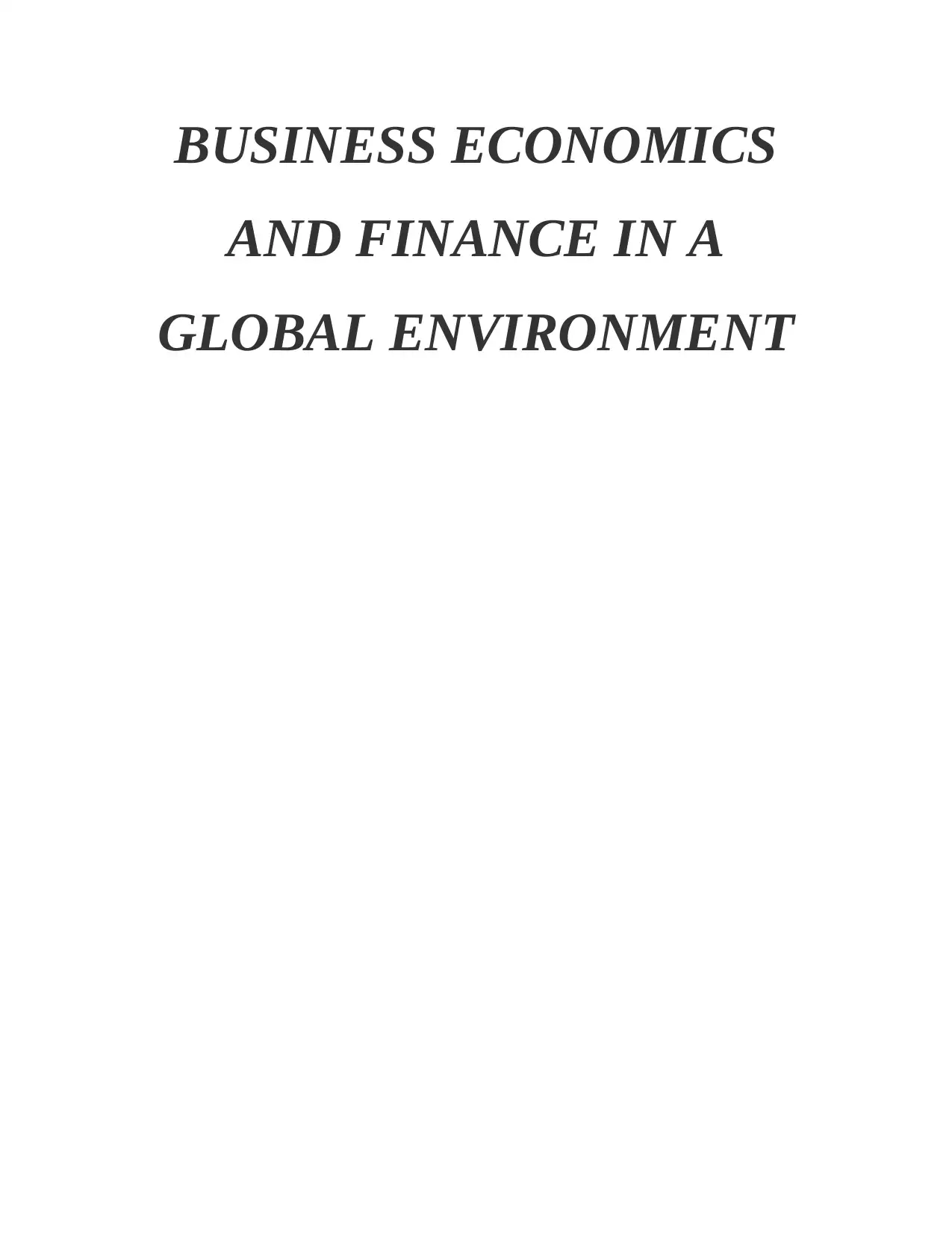
BUSINESS ECONOMICS
AND FINANCE IN A
GLOBAL ENVIRONMENT
AND FINANCE IN A
GLOBAL ENVIRONMENT
Paraphrase This Document
Need a fresh take? Get an instant paraphrase of this document with our AI Paraphraser
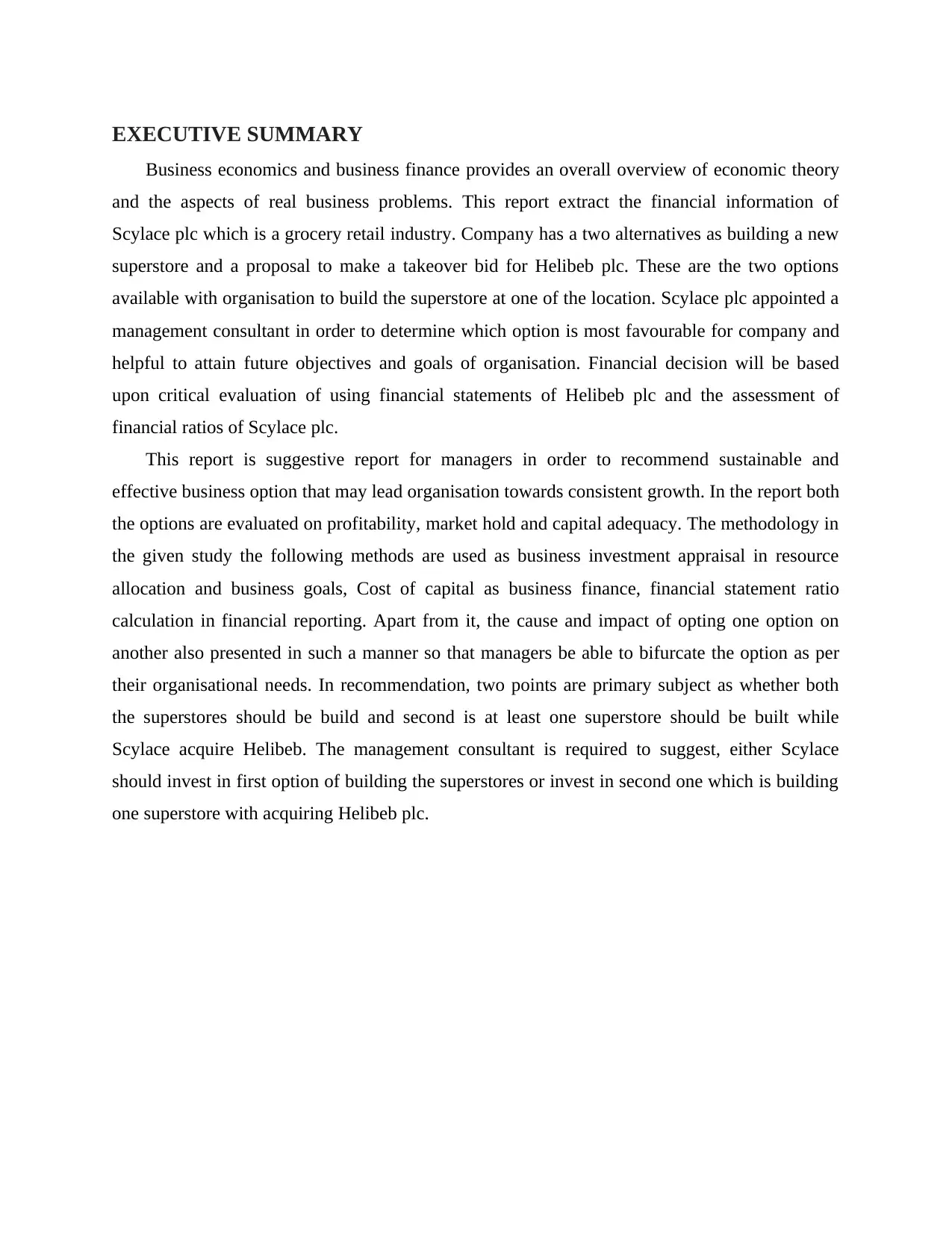
EXECUTIVE SUMMARY
Business economics and business finance provides an overall overview of economic theory
and the aspects of real business problems. This report extract the financial information of
Scylace plc which is a grocery retail industry. Company has a two alternatives as building a new
superstore and a proposal to make a takeover bid for Helibeb plc. These are the two options
available with organisation to build the superstore at one of the location. Scylace plc appointed a
management consultant in order to determine which option is most favourable for company and
helpful to attain future objectives and goals of organisation. Financial decision will be based
upon critical evaluation of using financial statements of Helibeb plc and the assessment of
financial ratios of Scylace plc.
This report is suggestive report for managers in order to recommend sustainable and
effective business option that may lead organisation towards consistent growth. In the report both
the options are evaluated on profitability, market hold and capital adequacy. The methodology in
the given study the following methods are used as business investment appraisal in resource
allocation and business goals, Cost of capital as business finance, financial statement ratio
calculation in financial reporting. Apart from it, the cause and impact of opting one option on
another also presented in such a manner so that managers be able to bifurcate the option as per
their organisational needs. In recommendation, two points are primary subject as whether both
the superstores should be build and second is at least one superstore should be built while
Scylace acquire Helibeb. The management consultant is required to suggest, either Scylace
should invest in first option of building the superstores or invest in second one which is building
one superstore with acquiring Helibeb plc.
Business economics and business finance provides an overall overview of economic theory
and the aspects of real business problems. This report extract the financial information of
Scylace plc which is a grocery retail industry. Company has a two alternatives as building a new
superstore and a proposal to make a takeover bid for Helibeb plc. These are the two options
available with organisation to build the superstore at one of the location. Scylace plc appointed a
management consultant in order to determine which option is most favourable for company and
helpful to attain future objectives and goals of organisation. Financial decision will be based
upon critical evaluation of using financial statements of Helibeb plc and the assessment of
financial ratios of Scylace plc.
This report is suggestive report for managers in order to recommend sustainable and
effective business option that may lead organisation towards consistent growth. In the report both
the options are evaluated on profitability, market hold and capital adequacy. The methodology in
the given study the following methods are used as business investment appraisal in resource
allocation and business goals, Cost of capital as business finance, financial statement ratio
calculation in financial reporting. Apart from it, the cause and impact of opting one option on
another also presented in such a manner so that managers be able to bifurcate the option as per
their organisational needs. In recommendation, two points are primary subject as whether both
the superstores should be build and second is at least one superstore should be built while
Scylace acquire Helibeb. The management consultant is required to suggest, either Scylace
should invest in first option of building the superstores or invest in second one which is building
one superstore with acquiring Helibeb plc.
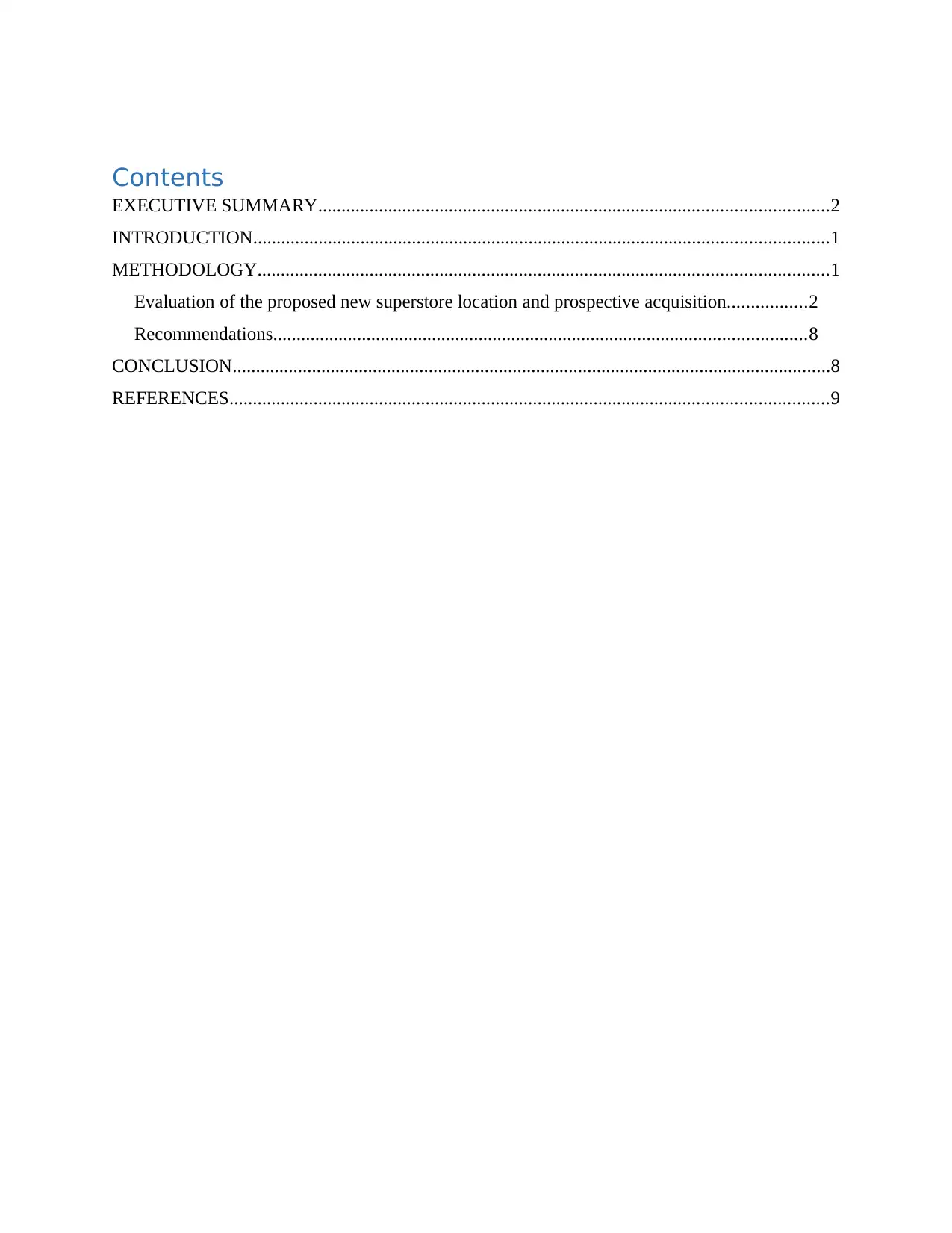
Contents
EXECUTIVE SUMMARY.............................................................................................................2
INTRODUCTION...........................................................................................................................1
METHODOLOGY..........................................................................................................................1
Evaluation of the proposed new superstore location and prospective acquisition.................2
Recommendations..................................................................................................................8
CONCLUSION................................................................................................................................8
REFERENCES................................................................................................................................9
EXECUTIVE SUMMARY.............................................................................................................2
INTRODUCTION...........................................................................................................................1
METHODOLOGY..........................................................................................................................1
Evaluation of the proposed new superstore location and prospective acquisition.................2
Recommendations..................................................................................................................8
CONCLUSION................................................................................................................................8
REFERENCES................................................................................................................................9
⊘ This is a preview!⊘
Do you want full access?
Subscribe today to unlock all pages.

Trusted by 1+ million students worldwide
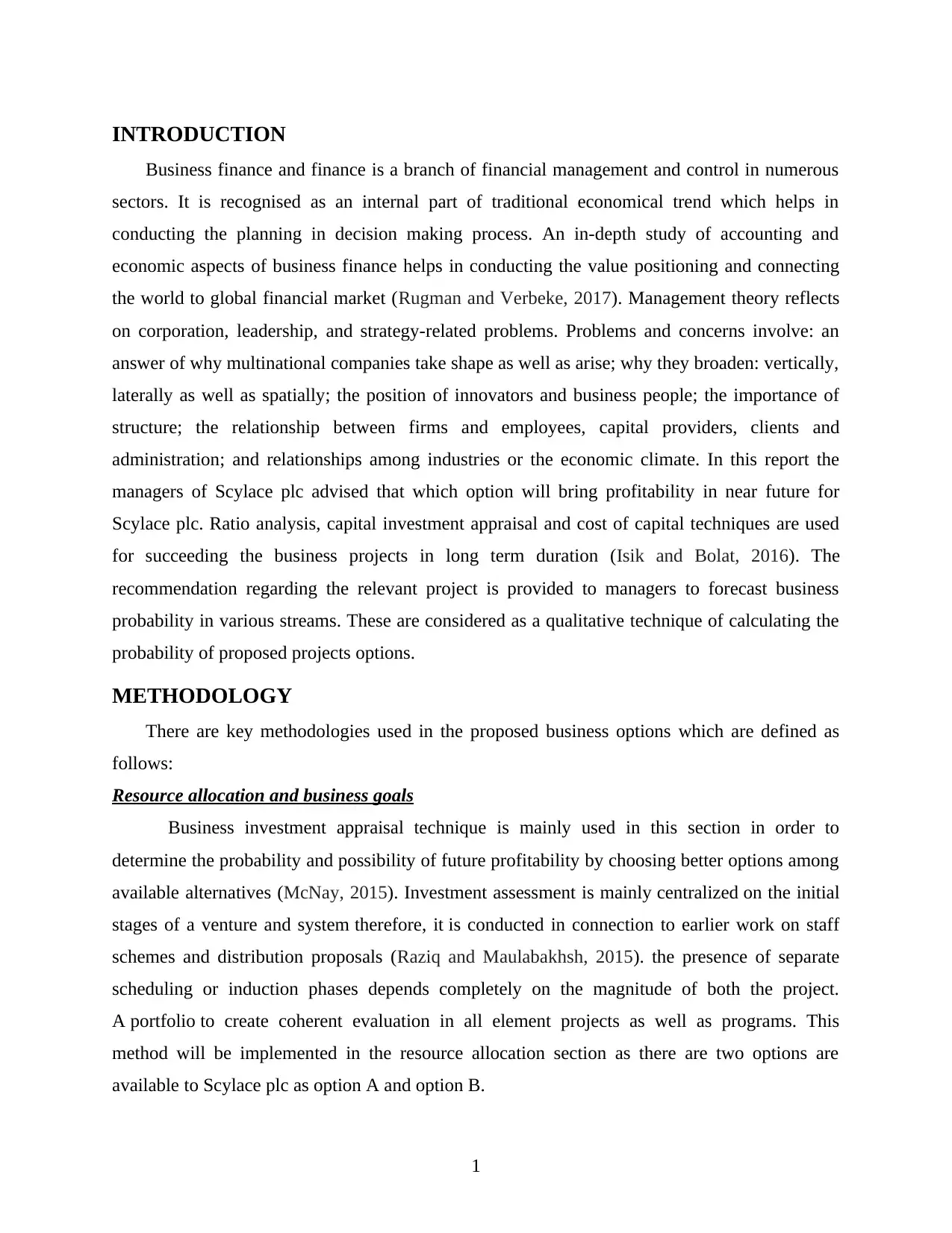
INTRODUCTION
Business finance and finance is a branch of financial management and control in numerous
sectors. It is recognised as an internal part of traditional economical trend which helps in
conducting the planning in decision making process. An in-depth study of accounting and
economic aspects of business finance helps in conducting the value positioning and connecting
the world to global financial market (Rugman and Verbeke, 2017). Management theory reflects
on corporation, leadership, and strategy-related problems. Problems and concerns involve: an
answer of why multinational companies take shape as well as arise; why they broaden: vertically,
laterally as well as spatially; the position of innovators and business people; the importance of
structure; the relationship between firms and employees, capital providers, clients and
administration; and relationships among industries or the economic climate. In this report the
managers of Scylace plc advised that which option will bring profitability in near future for
Scylace plc. Ratio analysis, capital investment appraisal and cost of capital techniques are used
for succeeding the business projects in long term duration (Isik and Bolat, 2016). The
recommendation regarding the relevant project is provided to managers to forecast business
probability in various streams. These are considered as a qualitative technique of calculating the
probability of proposed projects options.
METHODOLOGY
There are key methodologies used in the proposed business options which are defined as
follows:
Resource allocation and business goals
Business investment appraisal technique is mainly used in this section in order to
determine the probability and possibility of future profitability by choosing better options among
available alternatives (McNay, 2015). Investment assessment is mainly centralized on the initial
stages of a venture and system therefore, it is conducted in connection to earlier work on staff
schemes and distribution proposals (Raziq and Maulabakhsh, 2015). the presence of separate
scheduling or induction phases depends completely on the magnitude of both the project.
A portfolio to create coherent evaluation in all element projects as well as programs. This
method will be implemented in the resource allocation section as there are two options are
available to Scylace plc as option A and option B.
1
Business finance and finance is a branch of financial management and control in numerous
sectors. It is recognised as an internal part of traditional economical trend which helps in
conducting the planning in decision making process. An in-depth study of accounting and
economic aspects of business finance helps in conducting the value positioning and connecting
the world to global financial market (Rugman and Verbeke, 2017). Management theory reflects
on corporation, leadership, and strategy-related problems. Problems and concerns involve: an
answer of why multinational companies take shape as well as arise; why they broaden: vertically,
laterally as well as spatially; the position of innovators and business people; the importance of
structure; the relationship between firms and employees, capital providers, clients and
administration; and relationships among industries or the economic climate. In this report the
managers of Scylace plc advised that which option will bring profitability in near future for
Scylace plc. Ratio analysis, capital investment appraisal and cost of capital techniques are used
for succeeding the business projects in long term duration (Isik and Bolat, 2016). The
recommendation regarding the relevant project is provided to managers to forecast business
probability in various streams. These are considered as a qualitative technique of calculating the
probability of proposed projects options.
METHODOLOGY
There are key methodologies used in the proposed business options which are defined as
follows:
Resource allocation and business goals
Business investment appraisal technique is mainly used in this section in order to
determine the probability and possibility of future profitability by choosing better options among
available alternatives (McNay, 2015). Investment assessment is mainly centralized on the initial
stages of a venture and system therefore, it is conducted in connection to earlier work on staff
schemes and distribution proposals (Raziq and Maulabakhsh, 2015). the presence of separate
scheduling or induction phases depends completely on the magnitude of both the project.
A portfolio to create coherent evaluation in all element projects as well as programs. This
method will be implemented in the resource allocation section as there are two options are
available to Scylace plc as option A and option B.
1
Paraphrase This Document
Need a fresh take? Get an instant paraphrase of this document with our AI Paraphraser
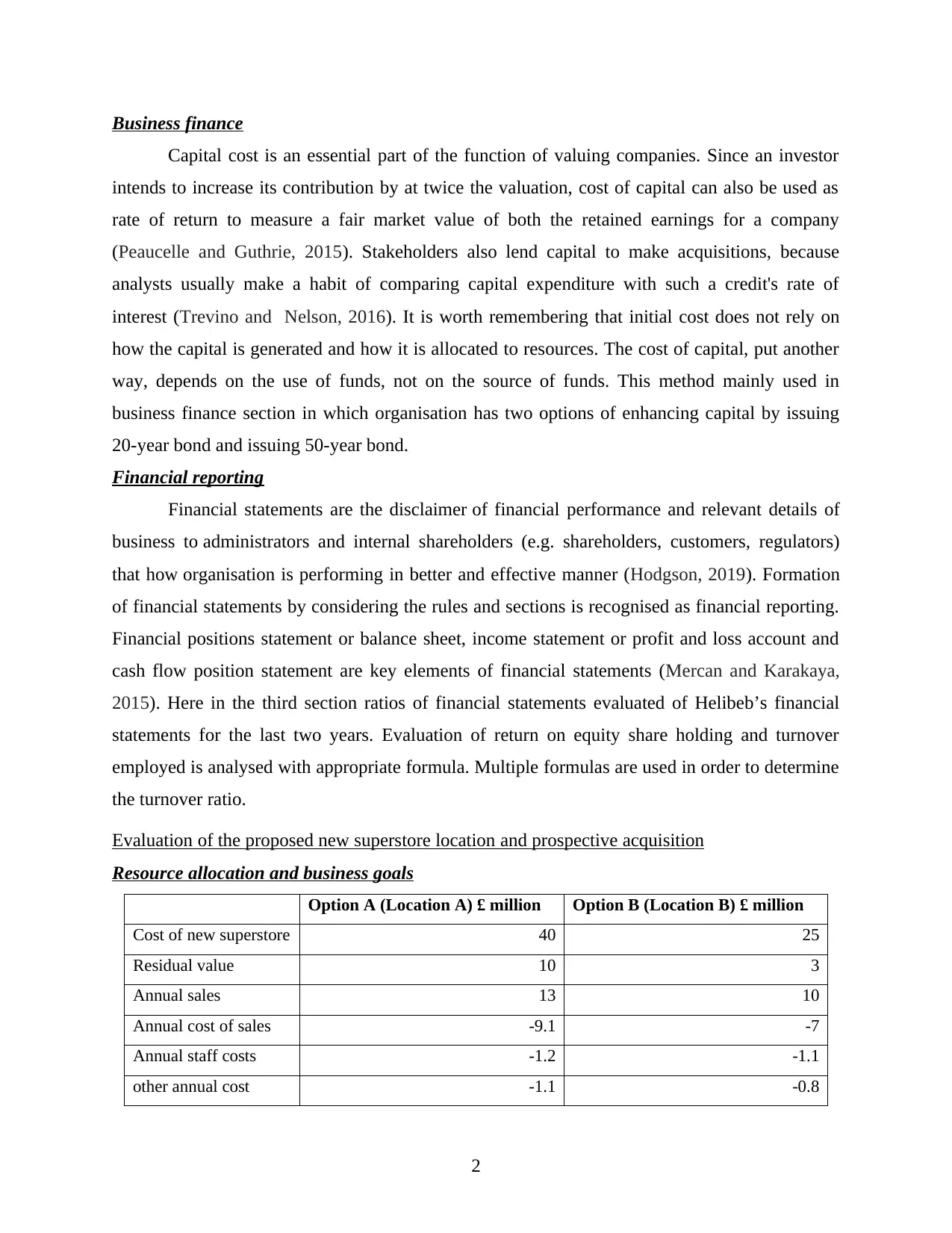
Business finance
Capital cost is an essential part of the function of valuing companies. Since an investor
intends to increase its contribution by at twice the valuation, cost of capital can also be used as
rate of return to measure a fair market value of both the retained earnings for a company
(Peaucelle and Guthrie, 2015). Stakeholders also lend capital to make acquisitions, because
analysts usually make a habit of comparing capital expenditure with such a credit's rate of
interest (Trevino and Nelson, 2016). It is worth remembering that initial cost does not rely on
how the capital is generated and how it is allocated to resources. The cost of capital, put another
way, depends on the use of funds, not on the source of funds. This method mainly used in
business finance section in which organisation has two options of enhancing capital by issuing
20-year bond and issuing 50-year bond.
Financial reporting
Financial statements are the disclaimer of financial performance and relevant details of
business to administrators and internal shareholders (e.g. shareholders, customers, regulators)
that how organisation is performing in better and effective manner (Hodgson, 2019). Formation
of financial statements by considering the rules and sections is recognised as financial reporting.
Financial positions statement or balance sheet, income statement or profit and loss account and
cash flow position statement are key elements of financial statements (Mercan and Karakaya,
2015). Here in the third section ratios of financial statements evaluated of Helibeb’s financial
statements for the last two years. Evaluation of return on equity share holding and turnover
employed is analysed with appropriate formula. Multiple formulas are used in order to determine
the turnover ratio.
Evaluation of the proposed new superstore location and prospective acquisition
Resource allocation and business goals
Option A (Location A) £ million Option B (Location B) £ million
Cost of new superstore 40 25
Residual value 10 3
Annual sales 13 10
Annual cost of sales -9.1 -7
Annual staff costs -1.2 -1.1
other annual cost -1.1 -0.8
2
Capital cost is an essential part of the function of valuing companies. Since an investor
intends to increase its contribution by at twice the valuation, cost of capital can also be used as
rate of return to measure a fair market value of both the retained earnings for a company
(Peaucelle and Guthrie, 2015). Stakeholders also lend capital to make acquisitions, because
analysts usually make a habit of comparing capital expenditure with such a credit's rate of
interest (Trevino and Nelson, 2016). It is worth remembering that initial cost does not rely on
how the capital is generated and how it is allocated to resources. The cost of capital, put another
way, depends on the use of funds, not on the source of funds. This method mainly used in
business finance section in which organisation has two options of enhancing capital by issuing
20-year bond and issuing 50-year bond.
Financial reporting
Financial statements are the disclaimer of financial performance and relevant details of
business to administrators and internal shareholders (e.g. shareholders, customers, regulators)
that how organisation is performing in better and effective manner (Hodgson, 2019). Formation
of financial statements by considering the rules and sections is recognised as financial reporting.
Financial positions statement or balance sheet, income statement or profit and loss account and
cash flow position statement are key elements of financial statements (Mercan and Karakaya,
2015). Here in the third section ratios of financial statements evaluated of Helibeb’s financial
statements for the last two years. Evaluation of return on equity share holding and turnover
employed is analysed with appropriate formula. Multiple formulas are used in order to determine
the turnover ratio.
Evaluation of the proposed new superstore location and prospective acquisition
Resource allocation and business goals
Option A (Location A) £ million Option B (Location B) £ million
Cost of new superstore 40 25
Residual value 10 3
Annual sales 13 10
Annual cost of sales -9.1 -7
Annual staff costs -1.2 -1.1
other annual cost -1.1 -0.8
2
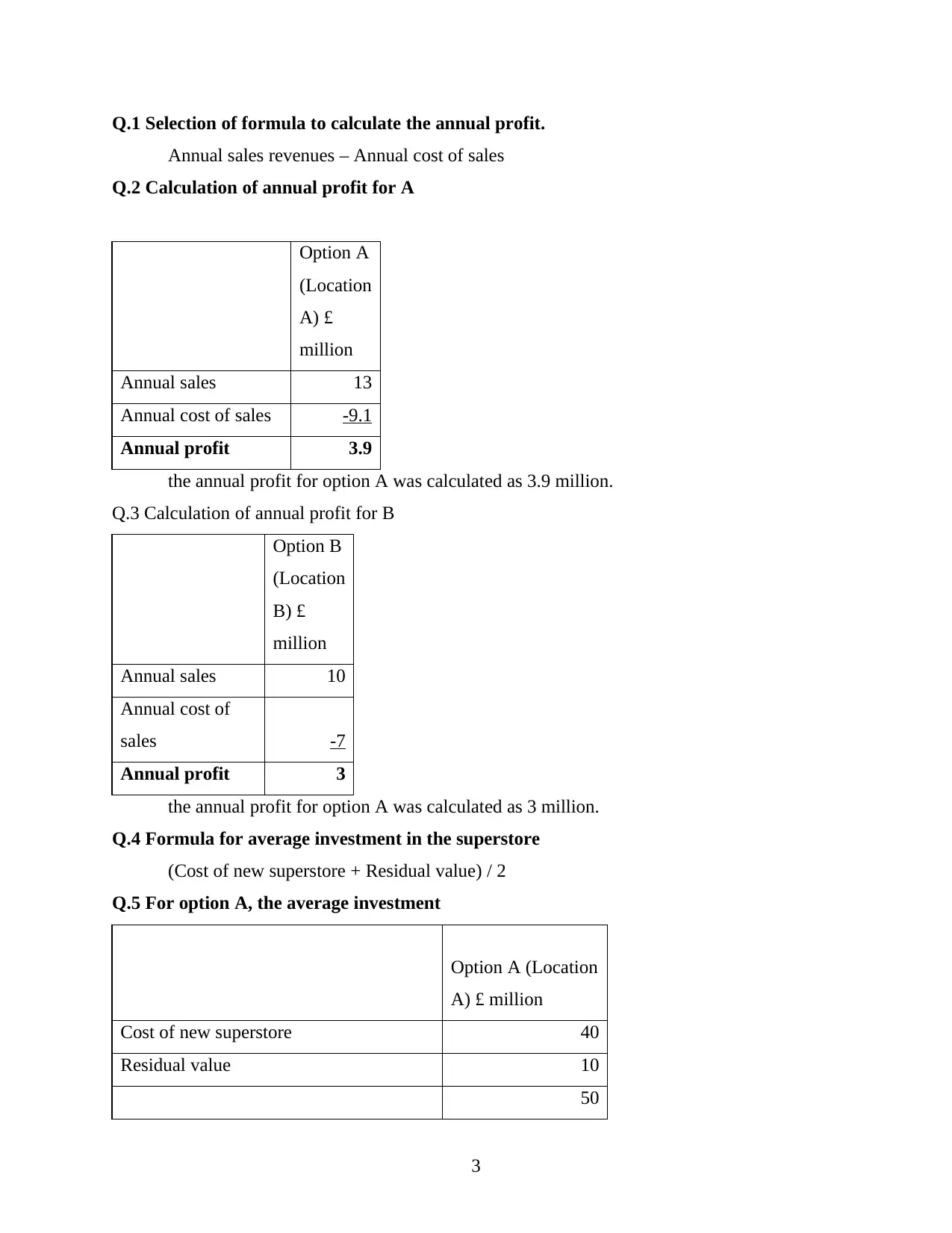
Q.1 Selection of formula to calculate the annual profit.
Annual sales revenues – Annual cost of sales
Q.2 Calculation of annual profit for A
Option A
(Location
A) £
million
Annual sales 13
Annual cost of sales -9.1
Annual profit 3.9
the annual profit for option A was calculated as 3.9 million.
Q.3 Calculation of annual profit for B
Option B
(Location
B) £
million
Annual sales 10
Annual cost of
sales -7
Annual profit 3
the annual profit for option A was calculated as 3 million.
Q.4 Formula for average investment in the superstore
(Cost of new superstore + Residual value) / 2
Q.5 For option A, the average investment
Option A (Location
A) £ million
Cost of new superstore 40
Residual value 10
50
3
Annual sales revenues – Annual cost of sales
Q.2 Calculation of annual profit for A
Option A
(Location
A) £
million
Annual sales 13
Annual cost of sales -9.1
Annual profit 3.9
the annual profit for option A was calculated as 3.9 million.
Q.3 Calculation of annual profit for B
Option B
(Location
B) £
million
Annual sales 10
Annual cost of
sales -7
Annual profit 3
the annual profit for option A was calculated as 3 million.
Q.4 Formula for average investment in the superstore
(Cost of new superstore + Residual value) / 2
Q.5 For option A, the average investment
Option A (Location
A) £ million
Cost of new superstore 40
Residual value 10
50
3
⊘ This is a preview!⊘
Do you want full access?
Subscribe today to unlock all pages.

Trusted by 1+ million students worldwide
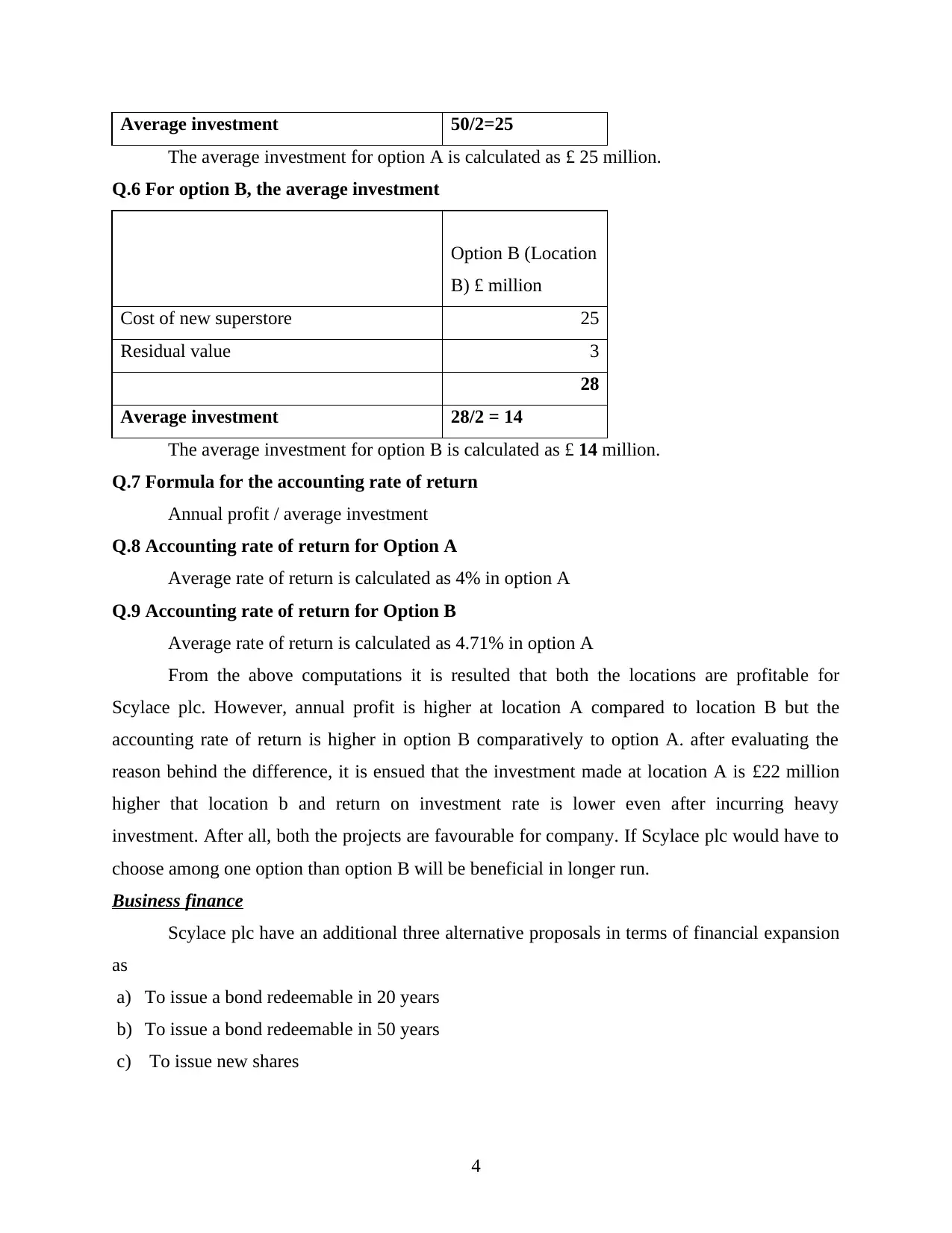
Average investment 50/2=25
The average investment for option A is calculated as £ 25 million.
Q.6 For option B, the average investment
Option B (Location
B) £ million
Cost of new superstore 25
Residual value 3
28
Average investment 28/2 = 14
The average investment for option B is calculated as £ 14 million.
Q.7 Formula for the accounting rate of return
Annual profit / average investment
Q.8 Accounting rate of return for Option A
Average rate of return is calculated as 4% in option A
Q.9 Accounting rate of return for Option B
Average rate of return is calculated as 4.71% in option A
From the above computations it is resulted that both the locations are profitable for
Scylace plc. However, annual profit is higher at location A compared to location B but the
accounting rate of return is higher in option B comparatively to option A. after evaluating the
reason behind the difference, it is ensued that the investment made at location A is £22 million
higher that location b and return on investment rate is lower even after incurring heavy
investment. After all, both the projects are favourable for company. If Scylace plc would have to
choose among one option than option B will be beneficial in longer run.
Business finance
Scylace plc have an additional three alternative proposals in terms of financial expansion
as
a) To issue a bond redeemable in 20 years
b) To issue a bond redeemable in 50 years
c) To issue new shares
4
The average investment for option A is calculated as £ 25 million.
Q.6 For option B, the average investment
Option B (Location
B) £ million
Cost of new superstore 25
Residual value 3
28
Average investment 28/2 = 14
The average investment for option B is calculated as £ 14 million.
Q.7 Formula for the accounting rate of return
Annual profit / average investment
Q.8 Accounting rate of return for Option A
Average rate of return is calculated as 4% in option A
Q.9 Accounting rate of return for Option B
Average rate of return is calculated as 4.71% in option A
From the above computations it is resulted that both the locations are profitable for
Scylace plc. However, annual profit is higher at location A compared to location B but the
accounting rate of return is higher in option B comparatively to option A. after evaluating the
reason behind the difference, it is ensued that the investment made at location A is £22 million
higher that location b and return on investment rate is lower even after incurring heavy
investment. After all, both the projects are favourable for company. If Scylace plc would have to
choose among one option than option B will be beneficial in longer run.
Business finance
Scylace plc have an additional three alternative proposals in terms of financial expansion
as
a) To issue a bond redeemable in 20 years
b) To issue a bond redeemable in 50 years
c) To issue new shares
4
Paraphrase This Document
Need a fresh take? Get an instant paraphrase of this document with our AI Paraphraser
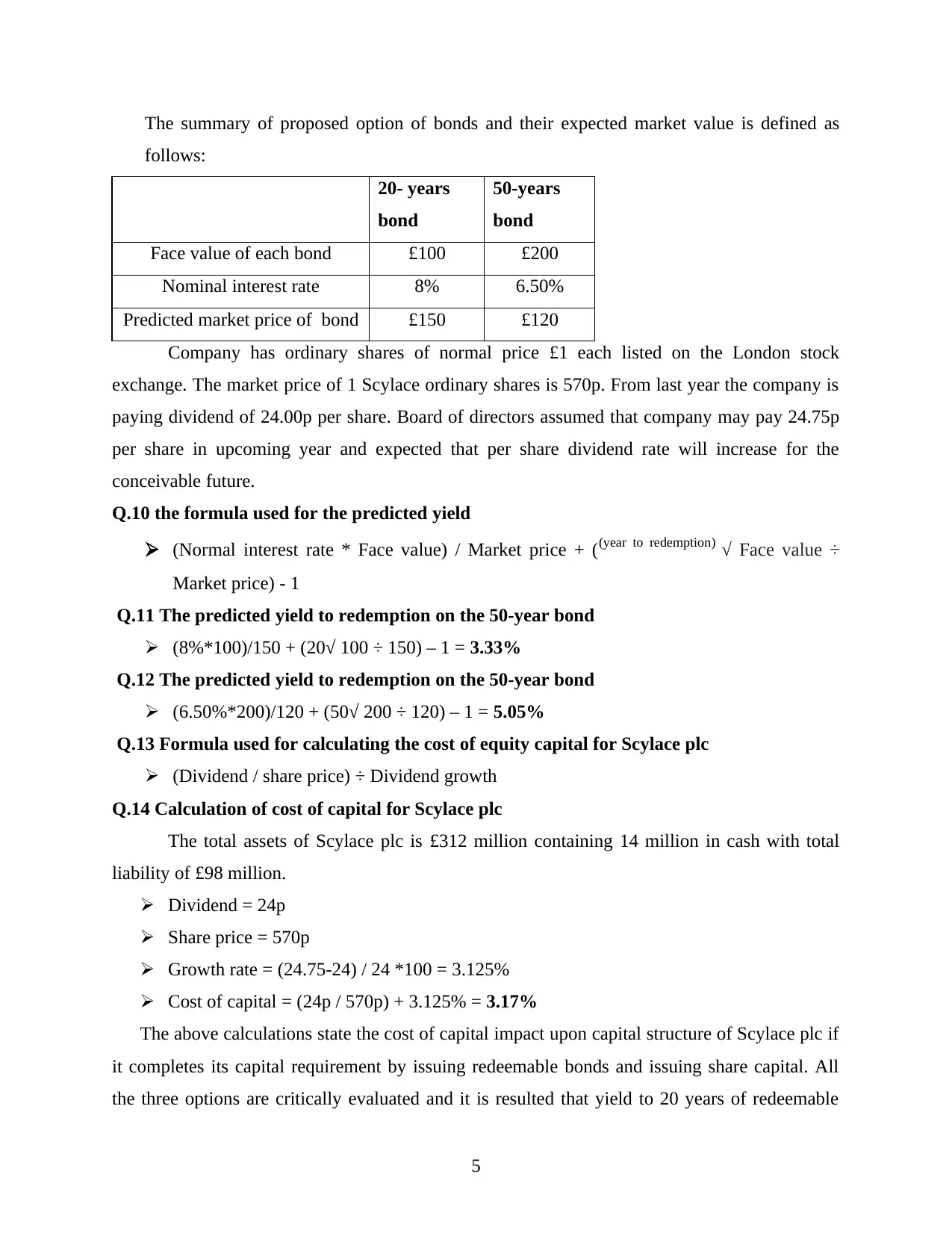
The summary of proposed option of bonds and their expected market value is defined as
follows:
20- years
bond
50-years
bond
Face value of each bond £100 £200
Nominal interest rate 8% 6.50%
Predicted market price of bond £150 £120
Company has ordinary shares of normal price £1 each listed on the London stock
exchange. The market price of 1 Scylace ordinary shares is 570p. From last year the company is
paying dividend of 24.00p per share. Board of directors assumed that company may pay 24.75p
per share in upcoming year and expected that per share dividend rate will increase for the
conceivable future.
Q.10 the formula used for the predicted yield
(Normal interest rate * Face value) / Market price + ((year to redemption) √ Face value ÷
Market price) - 1
Q.11 The predicted yield to redemption on the 50-year bond
(8%*100)/150 + (20√ 100 ÷ 150) – 1 = 3.33%
Q.12 The predicted yield to redemption on the 50-year bond
(6.50%*200)/120 + (50√ 200 ÷ 120) – 1 = 5.05%
Q.13 Formula used for calculating the cost of equity capital for Scylace plc
(Dividend / share price) ÷ Dividend growth
Q.14 Calculation of cost of capital for Scylace plc
The total assets of Scylace plc is £312 million containing 14 million in cash with total
liability of £98 million.
Dividend = 24p
Share price = 570p
Growth rate = (24.75-24) / 24 *100 = 3.125%
Cost of capital = (24p / 570p) + 3.125% = 3.17%
The above calculations state the cost of capital impact upon capital structure of Scylace plc if
it completes its capital requirement by issuing redeemable bonds and issuing share capital. All
the three options are critically evaluated and it is resulted that yield to 20 years of redeemable
5
follows:
20- years
bond
50-years
bond
Face value of each bond £100 £200
Nominal interest rate 8% 6.50%
Predicted market price of bond £150 £120
Company has ordinary shares of normal price £1 each listed on the London stock
exchange. The market price of 1 Scylace ordinary shares is 570p. From last year the company is
paying dividend of 24.00p per share. Board of directors assumed that company may pay 24.75p
per share in upcoming year and expected that per share dividend rate will increase for the
conceivable future.
Q.10 the formula used for the predicted yield
(Normal interest rate * Face value) / Market price + ((year to redemption) √ Face value ÷
Market price) - 1
Q.11 The predicted yield to redemption on the 50-year bond
(8%*100)/150 + (20√ 100 ÷ 150) – 1 = 3.33%
Q.12 The predicted yield to redemption on the 50-year bond
(6.50%*200)/120 + (50√ 200 ÷ 120) – 1 = 5.05%
Q.13 Formula used for calculating the cost of equity capital for Scylace plc
(Dividend / share price) ÷ Dividend growth
Q.14 Calculation of cost of capital for Scylace plc
The total assets of Scylace plc is £312 million containing 14 million in cash with total
liability of £98 million.
Dividend = 24p
Share price = 570p
Growth rate = (24.75-24) / 24 *100 = 3.125%
Cost of capital = (24p / 570p) + 3.125% = 3.17%
The above calculations state the cost of capital impact upon capital structure of Scylace plc if
it completes its capital requirement by issuing redeemable bonds and issuing share capital. All
the three options are critically evaluated and it is resulted that yield to 20 years of redeemable
5
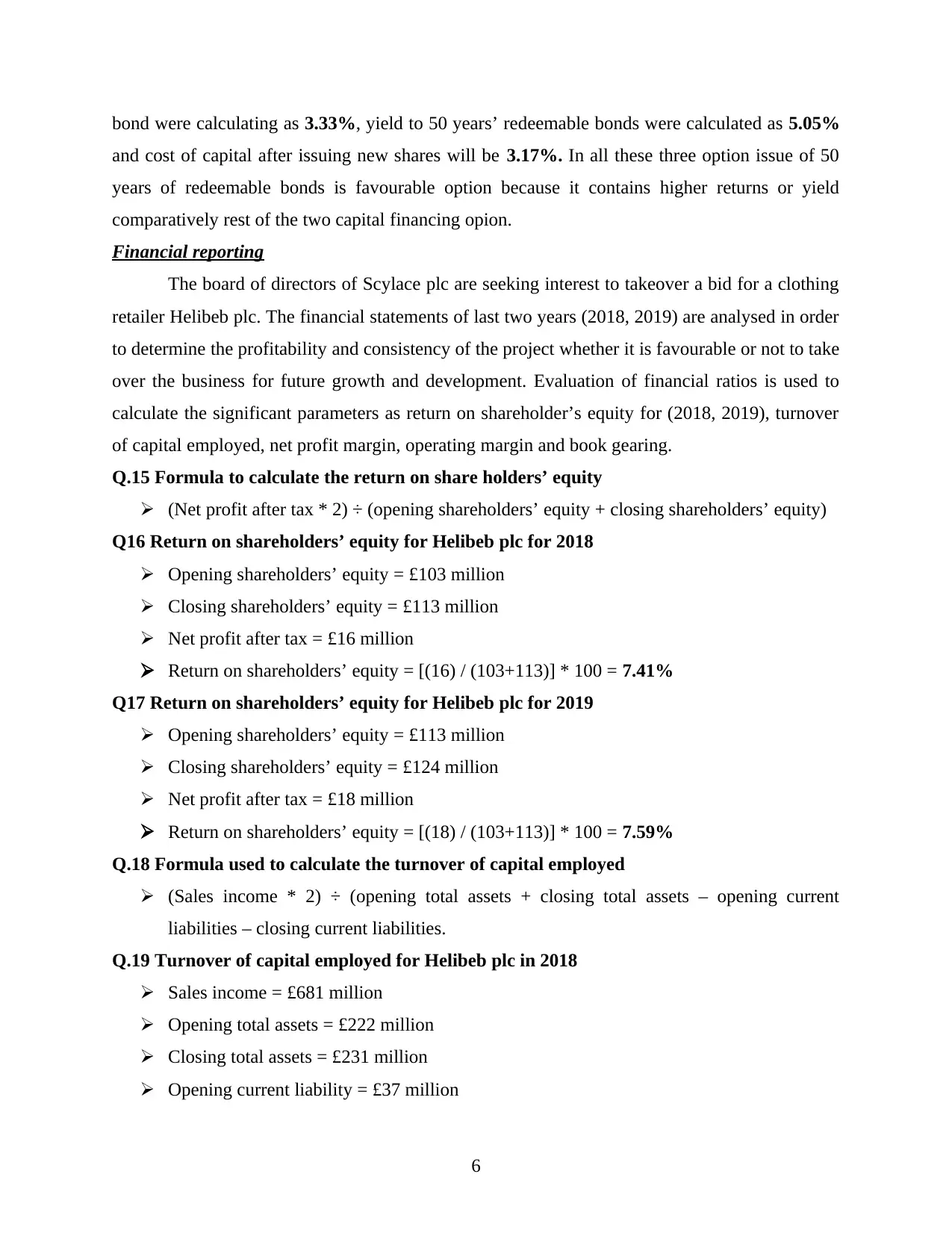
bond were calculating as 3.33%, yield to 50 years’ redeemable bonds were calculated as 5.05%
and cost of capital after issuing new shares will be 3.17%. In all these three option issue of 50
years of redeemable bonds is favourable option because it contains higher returns or yield
comparatively rest of the two capital financing opion.
Financial reporting
The board of directors of Scylace plc are seeking interest to takeover a bid for a clothing
retailer Helibeb plc. The financial statements of last two years (2018, 2019) are analysed in order
to determine the profitability and consistency of the project whether it is favourable or not to take
over the business for future growth and development. Evaluation of financial ratios is used to
calculate the significant parameters as return on shareholder’s equity for (2018, 2019), turnover
of capital employed, net profit margin, operating margin and book gearing.
Q.15 Formula to calculate the return on share holders’ equity
(Net profit after tax * 2) ÷ (opening shareholders’ equity + closing shareholders’ equity)
Q16 Return on shareholders’ equity for Helibeb plc for 2018
Opening shareholders’ equity = £103 million
Closing shareholders’ equity = £113 million
Net profit after tax = £16 million
Return on shareholders’ equity = [(16) / (103+113)] * 100 = 7.41%
Q17 Return on shareholders’ equity for Helibeb plc for 2019
Opening shareholders’ equity = £113 million
Closing shareholders’ equity = £124 million
Net profit after tax = £18 million
Return on shareholders’ equity = [(18) / (103+113)] * 100 = 7.59%
Q.18 Formula used to calculate the turnover of capital employed
(Sales income * 2) ÷ (opening total assets + closing total assets – opening current
liabilities – closing current liabilities.
Q.19 Turnover of capital employed for Helibeb plc in 2018
Sales income = £681 million
Opening total assets = £222 million
Closing total assets = £231 million
Opening current liability = £37 million
6
and cost of capital after issuing new shares will be 3.17%. In all these three option issue of 50
years of redeemable bonds is favourable option because it contains higher returns or yield
comparatively rest of the two capital financing opion.
Financial reporting
The board of directors of Scylace plc are seeking interest to takeover a bid for a clothing
retailer Helibeb plc. The financial statements of last two years (2018, 2019) are analysed in order
to determine the profitability and consistency of the project whether it is favourable or not to take
over the business for future growth and development. Evaluation of financial ratios is used to
calculate the significant parameters as return on shareholder’s equity for (2018, 2019), turnover
of capital employed, net profit margin, operating margin and book gearing.
Q.15 Formula to calculate the return on share holders’ equity
(Net profit after tax * 2) ÷ (opening shareholders’ equity + closing shareholders’ equity)
Q16 Return on shareholders’ equity for Helibeb plc for 2018
Opening shareholders’ equity = £103 million
Closing shareholders’ equity = £113 million
Net profit after tax = £16 million
Return on shareholders’ equity = [(16) / (103+113)] * 100 = 7.41%
Q17 Return on shareholders’ equity for Helibeb plc for 2019
Opening shareholders’ equity = £113 million
Closing shareholders’ equity = £124 million
Net profit after tax = £18 million
Return on shareholders’ equity = [(18) / (103+113)] * 100 = 7.59%
Q.18 Formula used to calculate the turnover of capital employed
(Sales income * 2) ÷ (opening total assets + closing total assets – opening current
liabilities – closing current liabilities.
Q.19 Turnover of capital employed for Helibeb plc in 2018
Sales income = £681 million
Opening total assets = £222 million
Closing total assets = £231 million
Opening current liability = £37 million
6
⊘ This is a preview!⊘
Do you want full access?
Subscribe today to unlock all pages.

Trusted by 1+ million students worldwide
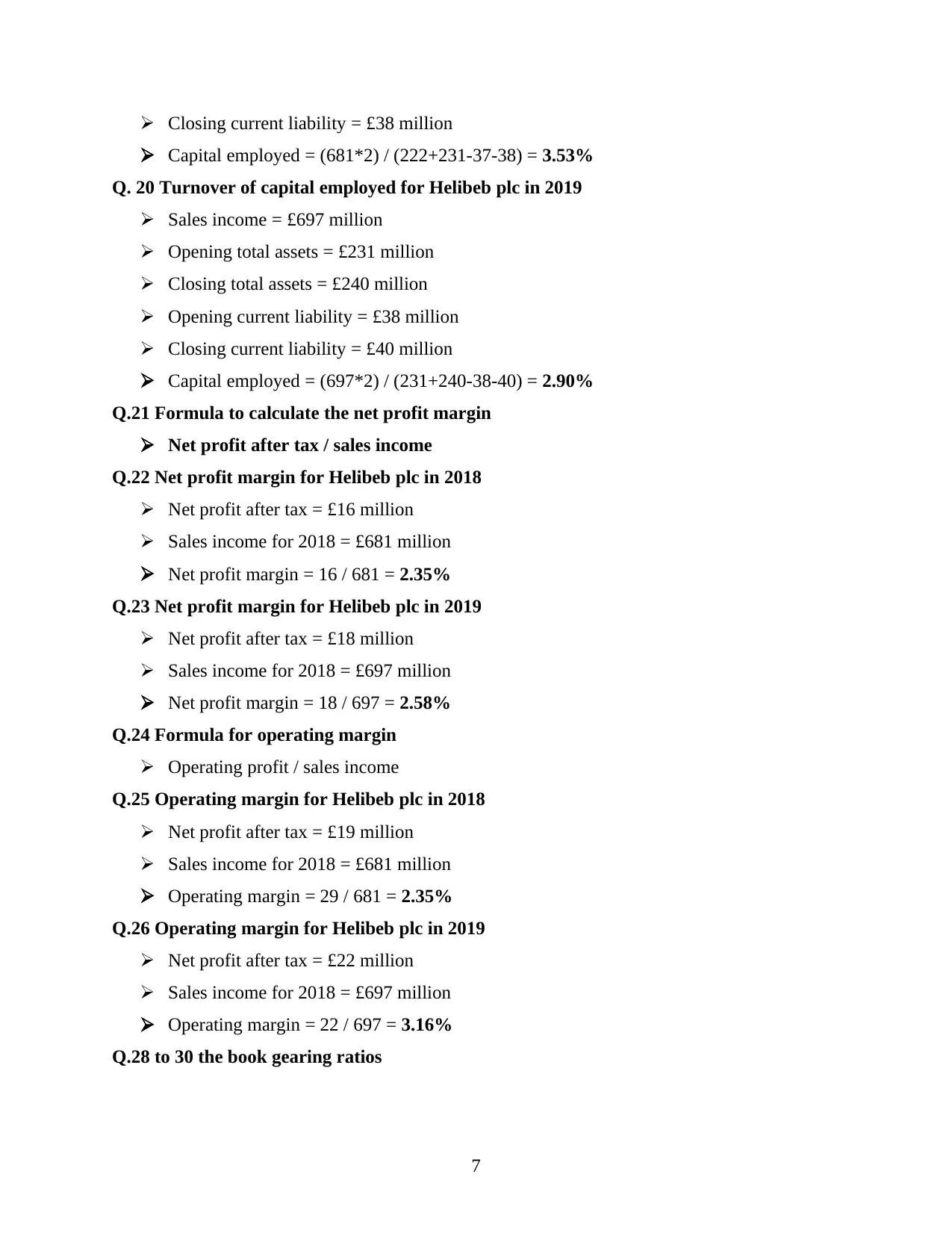
Closing current liability = £38 million
Capital employed = (681*2) / (222+231-37-38) = 3.53%
Q. 20 Turnover of capital employed for Helibeb plc in 2019
Sales income = £697 million
Opening total assets = £231 million
Closing total assets = £240 million
Opening current liability = £38 million
Closing current liability = £40 million
Capital employed = (697*2) / (231+240-38-40) = 2.90%
Q.21 Formula to calculate the net profit margin
Net profit after tax / sales income
Q.22 Net profit margin for Helibeb plc in 2018
Net profit after tax = £16 million
Sales income for 2018 = £681 million
Net profit margin = 16 / 681 = 2.35%
Q.23 Net profit margin for Helibeb plc in 2019
Net profit after tax = £18 million
Sales income for 2018 = £697 million
Net profit margin = 18 / 697 = 2.58%
Q.24 Formula for operating margin
Operating profit / sales income
Q.25 Operating margin for Helibeb plc in 2018
Net profit after tax = £19 million
Sales income for 2018 = £681 million
Operating margin = 29 / 681 = 2.35%
Q.26 Operating margin for Helibeb plc in 2019
Net profit after tax = £22 million
Sales income for 2018 = £697 million
Operating margin = 22 / 697 = 3.16%
Q.28 to 30 the book gearing ratios
7
Capital employed = (681*2) / (222+231-37-38) = 3.53%
Q. 20 Turnover of capital employed for Helibeb plc in 2019
Sales income = £697 million
Opening total assets = £231 million
Closing total assets = £240 million
Opening current liability = £38 million
Closing current liability = £40 million
Capital employed = (697*2) / (231+240-38-40) = 2.90%
Q.21 Formula to calculate the net profit margin
Net profit after tax / sales income
Q.22 Net profit margin for Helibeb plc in 2018
Net profit after tax = £16 million
Sales income for 2018 = £681 million
Net profit margin = 16 / 681 = 2.35%
Q.23 Net profit margin for Helibeb plc in 2019
Net profit after tax = £18 million
Sales income for 2018 = £697 million
Net profit margin = 18 / 697 = 2.58%
Q.24 Formula for operating margin
Operating profit / sales income
Q.25 Operating margin for Helibeb plc in 2018
Net profit after tax = £19 million
Sales income for 2018 = £681 million
Operating margin = 29 / 681 = 2.35%
Q.26 Operating margin for Helibeb plc in 2019
Net profit after tax = £22 million
Sales income for 2018 = £697 million
Operating margin = 22 / 697 = 3.16%
Q.28 to 30 the book gearing ratios
7
Paraphrase This Document
Need a fresh take? Get an instant paraphrase of this document with our AI Paraphraser
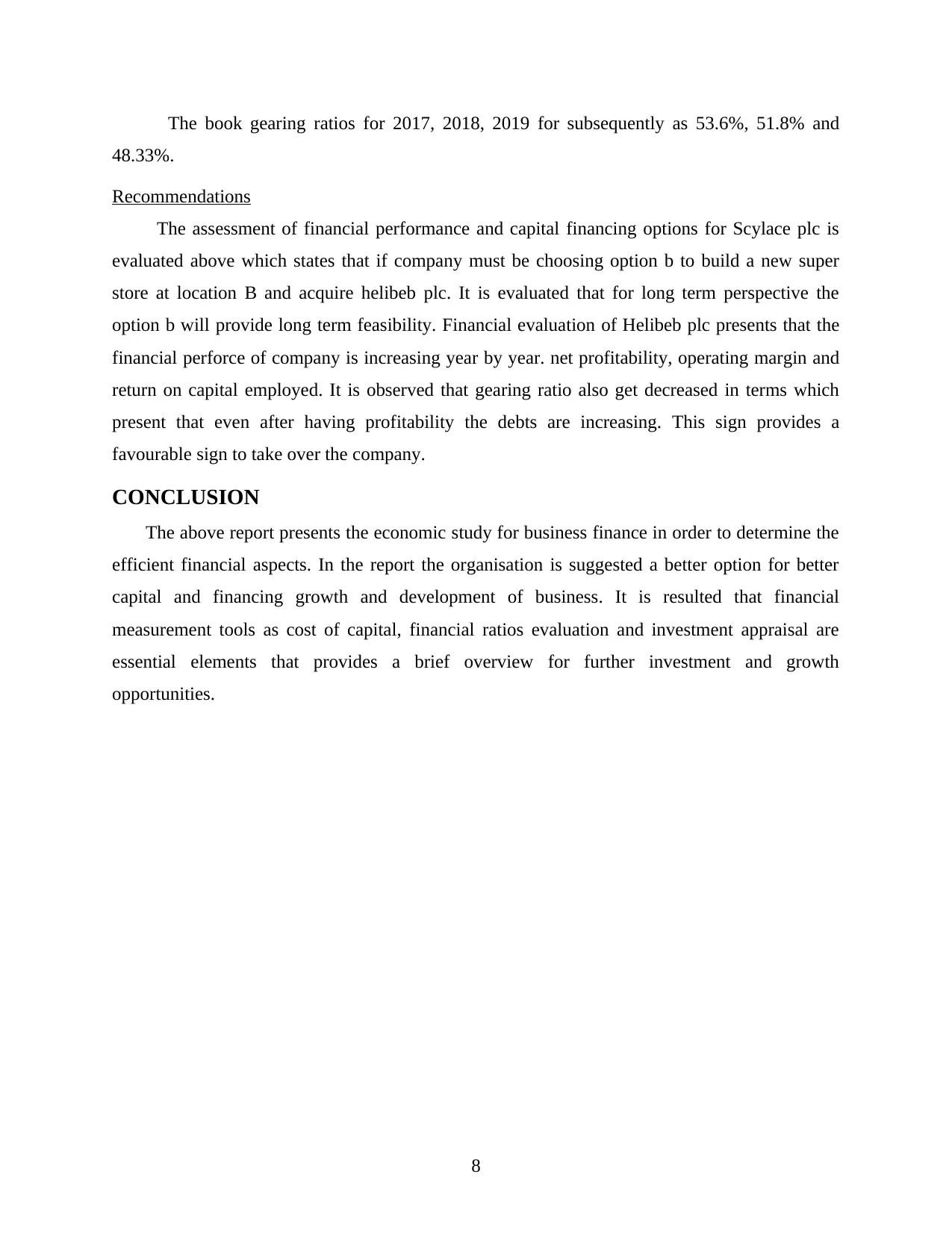
The book gearing ratios for 2017, 2018, 2019 for subsequently as 53.6%, 51.8% and
48.33%.
Recommendations
The assessment of financial performance and capital financing options for Scylace plc is
evaluated above which states that if company must be choosing option b to build a new super
store at location B and acquire helibeb plc. It is evaluated that for long term perspective the
option b will provide long term feasibility. Financial evaluation of Helibeb plc presents that the
financial perforce of company is increasing year by year. net profitability, operating margin and
return on capital employed. It is observed that gearing ratio also get decreased in terms which
present that even after having profitability the debts are increasing. This sign provides a
favourable sign to take over the company.
CONCLUSION
The above report presents the economic study for business finance in order to determine the
efficient financial aspects. In the report the organisation is suggested a better option for better
capital and financing growth and development of business. It is resulted that financial
measurement tools as cost of capital, financial ratios evaluation and investment appraisal are
essential elements that provides a brief overview for further investment and growth
opportunities.
8
48.33%.
Recommendations
The assessment of financial performance and capital financing options for Scylace plc is
evaluated above which states that if company must be choosing option b to build a new super
store at location B and acquire helibeb plc. It is evaluated that for long term perspective the
option b will provide long term feasibility. Financial evaluation of Helibeb plc presents that the
financial perforce of company is increasing year by year. net profitability, operating margin and
return on capital employed. It is observed that gearing ratio also get decreased in terms which
present that even after having profitability the debts are increasing. This sign provides a
favourable sign to take over the company.
CONCLUSION
The above report presents the economic study for business finance in order to determine the
efficient financial aspects. In the report the organisation is suggested a better option for better
capital and financing growth and development of business. It is resulted that financial
measurement tools as cost of capital, financial ratios evaluation and investment appraisal are
essential elements that provides a brief overview for further investment and growth
opportunities.
8
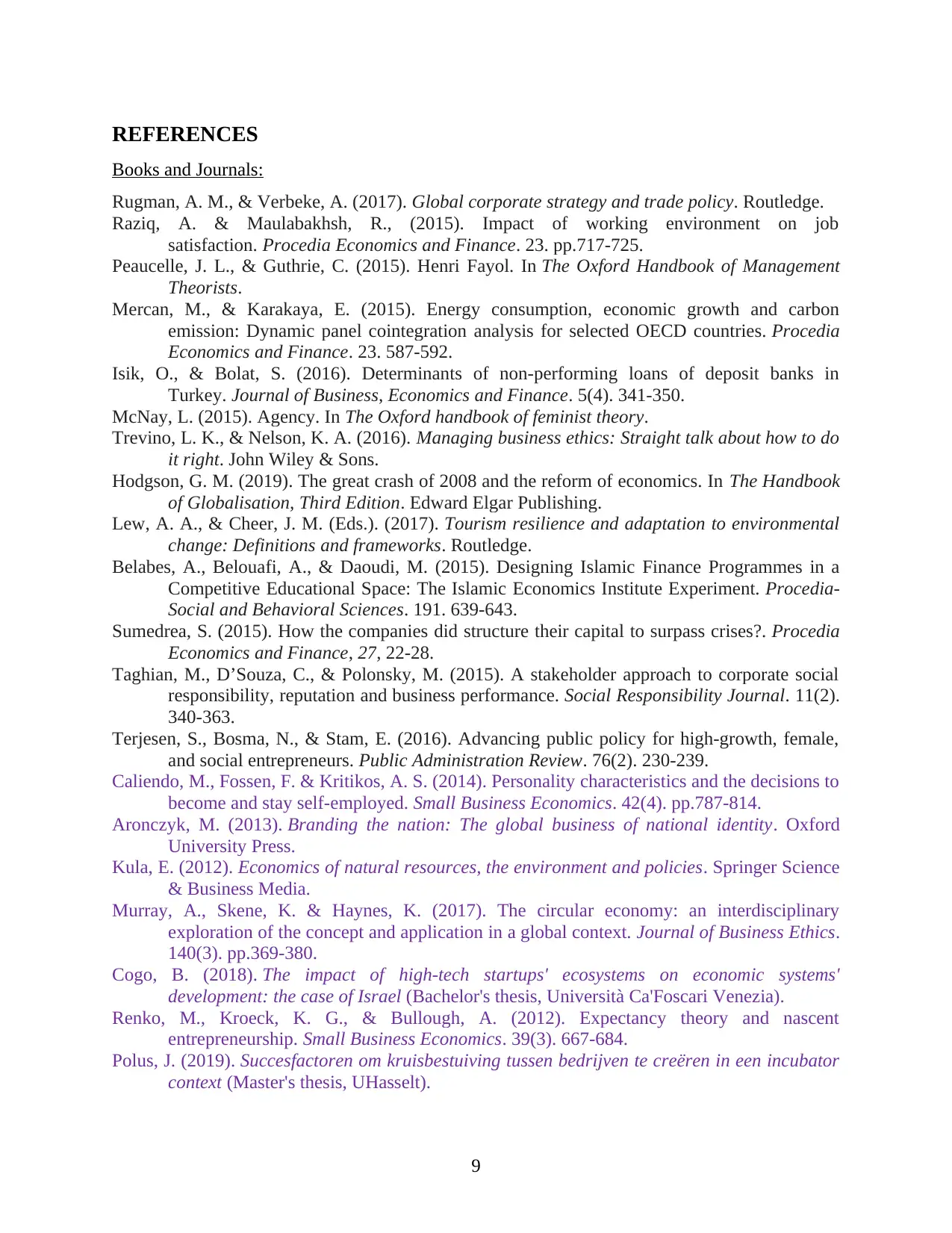
REFERENCES
Books and Journals:
Rugman, A. M., & Verbeke, A. (2017). Global corporate strategy and trade policy. Routledge.
Raziq, A. & Maulabakhsh, R., (2015). Impact of working environment on job
satisfaction. Procedia Economics and Finance. 23. pp.717-725.
Peaucelle, J. L., & Guthrie, C. (2015). Henri Fayol. In The Oxford Handbook of Management
Theorists.
Mercan, M., & Karakaya, E. (2015). Energy consumption, economic growth and carbon
emission: Dynamic panel cointegration analysis for selected OECD countries. Procedia
Economics and Finance. 23. 587-592.
Isik, O., & Bolat, S. (2016). Determinants of non-performing loans of deposit banks in
Turkey. Journal of Business, Economics and Finance. 5(4). 341-350.
McNay, L. (2015). Agency. In The Oxford handbook of feminist theory.
Trevino, L. K., & Nelson, K. A. (2016). Managing business ethics: Straight talk about how to do
it right. John Wiley & Sons.
Hodgson, G. M. (2019). The great crash of 2008 and the reform of economics. In The Handbook
of Globalisation, Third Edition. Edward Elgar Publishing.
Lew, A. A., & Cheer, J. M. (Eds.). (2017). Tourism resilience and adaptation to environmental
change: Definitions and frameworks. Routledge.
Belabes, A., Belouafi, A., & Daoudi, M. (2015). Designing Islamic Finance Programmes in a
Competitive Educational Space: The Islamic Economics Institute Experiment. Procedia-
Social and Behavioral Sciences. 191. 639-643.
Sumedrea, S. (2015). How the companies did structure their capital to surpass crises?. Procedia
Economics and Finance, 27, 22-28.
Taghian, M., D’Souza, C., & Polonsky, M. (2015). A stakeholder approach to corporate social
responsibility, reputation and business performance. Social Responsibility Journal. 11(2).
340-363.
Terjesen, S., Bosma, N., & Stam, E. (2016). Advancing public policy for high‐growth, female,
and social entrepreneurs. Public Administration Review. 76(2). 230-239.
Caliendo, M., Fossen, F. & Kritikos, A. S. (2014). Personality characteristics and the decisions to
become and stay self-employed. Small Business Economics. 42(4). pp.787-814.
Aronczyk, M. (2013). Branding the nation: The global business of national identity. Oxford
University Press.
Kula, E. (2012). Economics of natural resources, the environment and policies. Springer Science
& Business Media.
Murray, A., Skene, K. & Haynes, K. (2017). The circular economy: an interdisciplinary
exploration of the concept and application in a global context. Journal of Business Ethics.
140(3). pp.369-380.
Cogo, B. (2018). The impact of high-tech startups' ecosystems on economic systems'
development: the case of Israel (Bachelor's thesis, Università Ca'Foscari Venezia).
Renko, M., Kroeck, K. G., & Bullough, A. (2012). Expectancy theory and nascent
entrepreneurship. Small Business Economics. 39(3). 667-684.
Polus, J. (2019). Succesfactoren om kruisbestuiving tussen bedrijven te creëren in een incubator
context (Master's thesis, UHasselt).
9
Books and Journals:
Rugman, A. M., & Verbeke, A. (2017). Global corporate strategy and trade policy. Routledge.
Raziq, A. & Maulabakhsh, R., (2015). Impact of working environment on job
satisfaction. Procedia Economics and Finance. 23. pp.717-725.
Peaucelle, J. L., & Guthrie, C. (2015). Henri Fayol. In The Oxford Handbook of Management
Theorists.
Mercan, M., & Karakaya, E. (2015). Energy consumption, economic growth and carbon
emission: Dynamic panel cointegration analysis for selected OECD countries. Procedia
Economics and Finance. 23. 587-592.
Isik, O., & Bolat, S. (2016). Determinants of non-performing loans of deposit banks in
Turkey. Journal of Business, Economics and Finance. 5(4). 341-350.
McNay, L. (2015). Agency. In The Oxford handbook of feminist theory.
Trevino, L. K., & Nelson, K. A. (2016). Managing business ethics: Straight talk about how to do
it right. John Wiley & Sons.
Hodgson, G. M. (2019). The great crash of 2008 and the reform of economics. In The Handbook
of Globalisation, Third Edition. Edward Elgar Publishing.
Lew, A. A., & Cheer, J. M. (Eds.). (2017). Tourism resilience and adaptation to environmental
change: Definitions and frameworks. Routledge.
Belabes, A., Belouafi, A., & Daoudi, M. (2015). Designing Islamic Finance Programmes in a
Competitive Educational Space: The Islamic Economics Institute Experiment. Procedia-
Social and Behavioral Sciences. 191. 639-643.
Sumedrea, S. (2015). How the companies did structure their capital to surpass crises?. Procedia
Economics and Finance, 27, 22-28.
Taghian, M., D’Souza, C., & Polonsky, M. (2015). A stakeholder approach to corporate social
responsibility, reputation and business performance. Social Responsibility Journal. 11(2).
340-363.
Terjesen, S., Bosma, N., & Stam, E. (2016). Advancing public policy for high‐growth, female,
and social entrepreneurs. Public Administration Review. 76(2). 230-239.
Caliendo, M., Fossen, F. & Kritikos, A. S. (2014). Personality characteristics and the decisions to
become and stay self-employed. Small Business Economics. 42(4). pp.787-814.
Aronczyk, M. (2013). Branding the nation: The global business of national identity. Oxford
University Press.
Kula, E. (2012). Economics of natural resources, the environment and policies. Springer Science
& Business Media.
Murray, A., Skene, K. & Haynes, K. (2017). The circular economy: an interdisciplinary
exploration of the concept and application in a global context. Journal of Business Ethics.
140(3). pp.369-380.
Cogo, B. (2018). The impact of high-tech startups' ecosystems on economic systems'
development: the case of Israel (Bachelor's thesis, Università Ca'Foscari Venezia).
Renko, M., Kroeck, K. G., & Bullough, A. (2012). Expectancy theory and nascent
entrepreneurship. Small Business Economics. 39(3). 667-684.
Polus, J. (2019). Succesfactoren om kruisbestuiving tussen bedrijven te creëren in een incubator
context (Master's thesis, UHasselt).
9
⊘ This is a preview!⊘
Do you want full access?
Subscribe today to unlock all pages.

Trusted by 1+ million students worldwide
1 out of 12
Related Documents
Your All-in-One AI-Powered Toolkit for Academic Success.
+13062052269
info@desklib.com
Available 24*7 on WhatsApp / Email
![[object Object]](/_next/static/media/star-bottom.7253800d.svg)
Unlock your academic potential
Copyright © 2020–2025 A2Z Services. All Rights Reserved. Developed and managed by ZUCOL.





